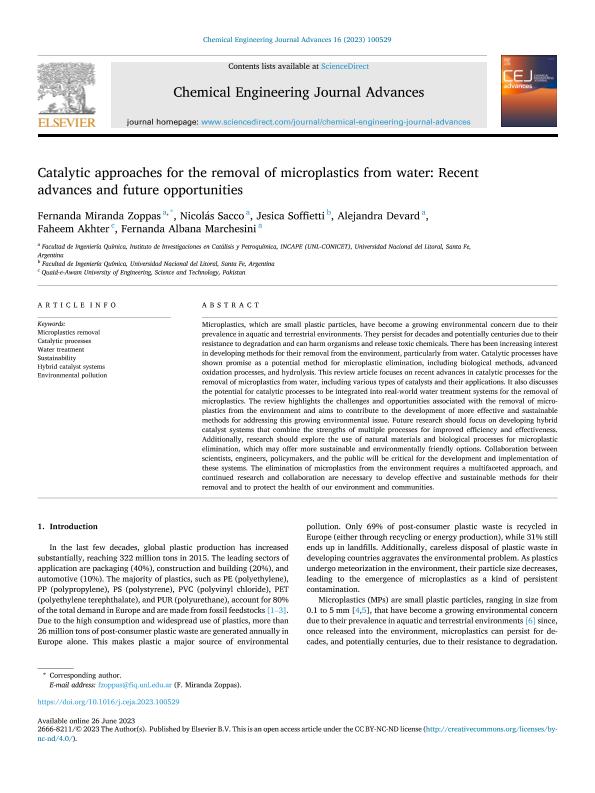Mostrar el registro sencillo del ítem
dc.contributor.author
Miranda Zoppas, Fernanda

dc.contributor.author
Sacco, Nicolás Alejandro

dc.contributor.author
Devard, Alejandra Veronica

dc.contributor.author
Soffietti, Jesica Beatriz

dc.contributor.author
Akhter, Faheem
dc.contributor.author
Marchesini, Fernanda Albana

dc.date.available
2024-03-07T13:49:31Z
dc.date.issued
2023-04
dc.identifier.citation
Miranda Zoppas, Fernanda; Sacco, Nicolás Alejandro; Devard, Alejandra Veronica; Soffietti, Jesica Beatriz; Akhter, Faheem; et al.; Catalytic approaches for the removal of microplastics from water: Recent advances and future opportunities; Elsevier; Chemical Engineering Journal Advances; 16; 4-2023; 1-11
dc.identifier.issn
2666-8211
dc.identifier.uri
http://hdl.handle.net/11336/229715
dc.description.abstract
Microplastics, which are small plastic particles, have become a growing environmental concern due to their prevalence in aquatic and terrestrial environments. They persist for decades and potentially centuries due to their resistance to degradation and can harm organisms and release toxic chemicals. There has been increasing interest in developing methods for their removal from the environment, particularly from water. Catalytic processes have shown promise as a potential method for microplastic elimination, including oxidation, hydrolysis, and adsorption. This review article focuses on recent advances in catalytic processes for the removal of microplastics from water, including various types of catalysts and their applications. It also discusses the potential for catalytic processes to be integrated into real-world water treatment systems for the removal of microplastics. The review highlights the challenges and opportunities associated with the removal of microplastics from the environment and aims to contribute to the development of more effective and sustainable methods for addressing this growing environmental issue. Future research should focus on developing hybrid catalyst systems that combine the strengths of multiple processes for improved efficiency and effectiveness. Additionally, research should explore the use of natural materials and biological processes or microplastic elimination, which may offer more sustainable and environmentally friendly options. Collaboration between scientists, engineers, policymakers, and the public will be critical for the development and implementation of these systems. The elimination of microplastics from the environment requires a multifaceted approach, and continued research and collaboration are necessary to develop effective and sustainable methods for their removal and to protect the health of our environment and communities.
dc.format
application/pdf
dc.language.iso
eng
dc.publisher
Elsevier

dc.rights
info:eu-repo/semantics/openAccess
dc.rights.uri
https://creativecommons.org/licenses/by-nc-nd/2.5/ar/
dc.subject
MICROPLASTICS REMOVAL
dc.subject
CATALYTIC PROCESSES
dc.subject
WATER TREATMENT
dc.subject
SUSTAINABILITY
dc.subject.classification
Otras Ingeniería Química

dc.subject.classification
Ingeniería Química

dc.subject.classification
INGENIERÍAS Y TECNOLOGÍAS

dc.title
Catalytic approaches for the removal of microplastics from water: Recent advances and future opportunities
dc.type
info:eu-repo/semantics/article
dc.type
info:ar-repo/semantics/artículo
dc.type
info:eu-repo/semantics/publishedVersion
dc.date.updated
2024-02-05T13:51:55Z
dc.journal.volume
16
dc.journal.pagination
1-11
dc.journal.pais
Países Bajos

dc.journal.ciudad
Amsterdam
dc.description.fil
Fil: Miranda Zoppas, Fernanda. Consejo Nacional de Investigaciones Científicas y Técnicas. Centro Científico Tecnológico Conicet - Santa Fe. Instituto de Investigaciones en Catálisis y Petroquímica "Ing. José Miguel Parera". Universidad Nacional del Litoral. Instituto de Investigaciones en Catálisis y Petroquímica "Ing. José Miguel Parera"; Argentina
dc.description.fil
Fil: Sacco, Nicolás Alejandro. Consejo Nacional de Investigaciones Científicas y Técnicas. Centro Científico Tecnológico Conicet - Santa Fe. Instituto de Investigaciones en Catálisis y Petroquímica "Ing. José Miguel Parera". Universidad Nacional del Litoral. Instituto de Investigaciones en Catálisis y Petroquímica "Ing. José Miguel Parera"; Argentina
dc.description.fil
Fil: Devard, Alejandra Veronica. Consejo Nacional de Investigaciones Científicas y Técnicas. Centro Científico Tecnológico Conicet - Santa Fe. Instituto de Investigaciones en Catálisis y Petroquímica "Ing. José Miguel Parera". Universidad Nacional del Litoral. Instituto de Investigaciones en Catálisis y Petroquímica "Ing. José Miguel Parera"; Argentina
dc.description.fil
Fil: Soffietti, Jesica Beatriz. Universidad Nacional del Litoral. Instituto de Química Aplicada del Litoral. Consejo Nacional de Investigaciones Científicas y Técnicas. Centro Científico Tecnológico Conicet - Santa Fe. Instituto de Química Aplicada del Litoral.; Argentina
dc.description.fil
Fil: Akhter, Faheem. Quaid-e-Awam University of Engineering; Pakistán
dc.description.fil
Fil: Marchesini, Fernanda Albana. Consejo Nacional de Investigaciones Científicas y Técnicas. Centro Científico Tecnológico Conicet - Santa Fe. Instituto de Investigaciones en Catálisis y Petroquímica "Ing. José Miguel Parera". Universidad Nacional del Litoral. Instituto de Investigaciones en Catálisis y Petroquímica "Ing. José Miguel Parera"; Argentina
dc.journal.title
Chemical Engineering Journal Advances
dc.relation.alternativeid
info:eu-repo/semantics/altIdentifier/url/https://www.sciencedirect.com/science/article/pii/S2666821123000868
dc.relation.alternativeid
info:eu-repo/semantics/altIdentifier/doi/http://dx.doi.org/10.1016/j.ceja.2023.100529
Archivos asociados
